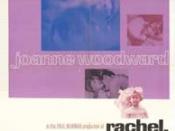ESSAY COMPARING "A JEST OF GOD" TO "THE FIRE-DWELLERS" The prominent life of Margaret Laurence, one of Canada's most renowned female authors, began on July 18, 1926, in the quaint prairie town of Neepawa, Manitoba. Unfortunately, at a very young age, Laurence suffered the tragic loss of both her parents. Laurence's love for literature gradually developed with the support and guidance of her stepmother, a teacher and a librarian. Early in life, Laurence decided she would fulfil her passion for literature by turning to a career in fictional writing. She used her brilliant writing skills to express her personal concern; the progress of women as they struggle for self-realization in a male-dominated world, thoroughly in many of her novels. Laurence's dedicated devotion to the female movement has been the powerful basis of several novels throughout her career, but most significantly in A Jest of God (1966) and The Fire-Dwellers (1969).
However, even after completing numerous novels concerning the equality of women, Laurence continued supporting significant issues, such as world peace, social justice, and environmental protection. Her life story is inspirational and her works emit an influential persona. Sadly, Laurence lost a battle to cancer and passed away on January 5, 1987, in Lakefield, Ontario. Many avid readers of Laurence find that both A Jest of God and The Fire-Dwellers depict essential elements of the lives of women in 1960s North America. However, it is The Fire-Dwellers that most explicitly and realistically portrays the women's movement. Through an analysis of Laurence's use of characterization and thematic structure, the external and internal conflicts facing women are made poignantly clear.
Laurence has the remarkable talent of starting from scratch and gradually creating personality traits to bring her characters to life. In A Jest of God, readers are introduced to the wearisome life of Rachel Cameron. Rachel is an elementary school teacher in Manawaka, Manitoba where she balances an unfulfilling existence between personal problems and problems of friends and family. At the age of thirty-four she still resides with her widowed mother in a small apartment above a Funeral home. Rachel seems respectful towards her mother on the outside, but fights back the urge to challenge her from within. She experiences a streak of bad luck that convinces her to commit suicide. Luckily, her attempts to take her own life are weak and force her to search for an alternative solution to her problems. Rachel takes a different approach in solving her dilemma. She realizes that her problem is not with those around her, but with herself. Rachel begins soul-searching and strives to find her "true" identity. Gradually, she learns to be defenceless towards love, to take risks, and to even realize her own foolishness. On occasion, Rachel loses sight of her identity and begins to pity her miserable life. Situations like these always conclude with a reference to Stacey, her older sister who escaped Manawaka to be free on her own. Rachel's jealousy towards Stacey is briefly explained when readers glimpse into Stacey's seemingly carefree life through Rachel's eyes. Laurence uses this clever tactic to connect the story of Rachel in A Jest of God to Stacey in The Fire-Dwellers.
It is the tale of The Fire-Dwellers, which sets Stacey's story straight. Rachel describes her sister as being a loving wife and mother, however in The Fire-Dwellers she is simply a heartbroken housewife who longs for a passion-driven life. She maintains a home in Vancouver, takes constant care of her four young children, helps her struggling salesperson husband, and deals with her bothersome father-in-law. Craving for a richer lifestyle, Stacey gambles her marriage and children in search of answers. Progressively, she learns to be grateful as a mother, wife, and woman, and learns to deal with her fears, desires, and marital problems. Laurence's talented writing uncovers Stacey's exceptional traits as a loving, courageous, and strong woman. As Laurence reveals the heroic stories of each individual character, readers begin appreciating and identifying with their admirable traits.
In A Jest of God, the hidden characteristics of the once timid Rachel are eventually exposed through her relationship with an old schoolmate, Nick Kazlik. Rachel is described as the confident, yet quiet character, miserably trapped in a fabricated existence. She loses her love of teaching, struggles with her mother's old age, and falls out of touch with her "true" self. With time, readers realize that Rachel subconsciously lives two separate lives. She portrays herself as being strong, hardworking, and loving, but secretly shares her genuine feelings with readers. Laurence demonstrates this by introducing Rachel's intimate thoughts after a superficial conversation with her mother: "Rachel - is it serious?" "Serious?" "Yes - I mean -" ⦠"No, it's not serious." "Well, dear, I mean to say, of course it's your own life, as I've often said -" "It's not serious ⦠did you take your sleeping pill?" ⦠If only she wouldn't question me. If only I could stop myself from answeringâ¦. why can't she die and leave me alone?â¦Mean. I am. I never knew it.
(A Jest of God, 120) Rachel's hidden character is exposed as being doubtful, rebellious, and even spiteful. Due to her split personality as an introvert and an outgoing individual, she struggles with many aspects of her life. Her personal thoughts also uncover how she fears reality and prefers to overlook the truth in her life: There. That's stating it as its most brutal possibility. Look at it, Rachel. And yet I don't believe it ⦠do I deceive myself? More than likely. I don't know - that's the thing.
(A Jest of God, 160) Rachel also fears her past, present, and future life story. Her fear of her past is best distinguished when she continuously refers to the blue neon sign blinking "Japonica Funeral Chapel" above her home doorstep. The sign includes a history that constantly reminds Rachel of her past life that included her father: When I was a child the sign was painted on board, pale-grey background, black lettering, and it said Cameron's Funeral Parlour. Later, my father, laughing in some way incomprehensible to me then and being chided for it by Mother, announced other times other manners. The new sign was ebony background and gilt lettering, Cameron Funeral Home. After he died, and we sold the establishment, the phraseology moved on. The blue neon, kept lighted day and night, now flashes Japonica Funeral Chapel. All that remains is for someone to delete the word funeral. A nasty word, smacking mortality.
(A Jest of God, 19) Throughout the novel, Rachel reminds readers of the hate and annoyance she feels towards the sign, implying the inadequate relationship she once shared with her father. In addition to the fear of her past, Rachel battles with her present daily life. She feels overwhelmed with responsibilities, forcing her to be impatient with her mother and students: "Come along, now. We haven't got all day. James, for goodness' sakes, stop dawding." Now I've spoken more sharply than necessary. I have to watch this, too. It's hard to strike a balance.
(A Jest of God, 9) Lastly, Rachel fears her future in the small town of Manawaka. She fears living a dreadful life identical to her mothers, without change or excitement. As a result, of her mother's unstable health condition, Rachel feels trapped and tied down to a miserable future. Rachel constantly hopes to move away and expresses her jealousy of Stacey who lives freely on her own. Unfortunately, their mother's heath prevents Rachel from escaping the dull borders of Manitoba to live a life similar to Stacey's.
A Jest of God, describes Stacey as being, "⦠so positive [that] she understands everything" (28), however it is through The Fire-Dwellers, that Laurence portrays her authentic personality. Stacey is a woman who is broken up inside and practically doubtful of all aspects in her life. Her relationship with her husband, her daughter, and herself lack a sense of satisfaction, leaving her vulnerable to any situation. She loses the gratitude of being a wife and mother and finds herself searching for love in unimaginable places. Unlike Rachel, Stacey demonstrates her assertiveness with her family and friends; she does not sit back and passively watch as her life crumbles before her. Stacey holds on to the rich life she led as a teenager and tackles an aggressive role in reclaiming her love for life. Laurence depicts this well through Stacey's affair with Luke, the young adventurer. Stacey learns to take responsibility for her actions and face reality. This is proven near the end when Stacey realizes the truth about her existence.
I was wrong to think of the trap as the four walls. It's the world. The truth is that I haven't been Stacey Cameron for one hell of a long time now. Although in some ways I'll always be her, because that's how I started out. But from now on, the dancing goes on only in the head ⦠well, in the head isn't such a terrible pace to dance. The settings are magnificent there, anyhow. I did dance at one time, when I could. It would be a lot worse if I never had.
(The Fire-Dwellers, 276) Stacey understands that her life was well spent and learns that it is still nevertheless just as grand. She depicts a courageous woman who never gave up on herself or her family. Although Stacey dealt with difficult issues in regards to her marriage, children, and role as a housewife, she was determined to regain her stability and contentment in life. She defines the ideal heroine, who battled, realized, and recovered her identity as not only a wife and mother, but also a woman. Stacey learns to appreciate life's little gifts and discovers a source of pleasure in the tiresome routine of her days. Much like Rachel, Stacey also struggles to find her identity, but better approaches her journey. She fulfils the role of a heroine by completing a full cycle before making her breakthrough in life. This is best explained through the first and last chapters that are practically identical, revealing Stacey's circle of life.
First Chapter: The bed is unmade, and on a chair rests a jumble of her clothes, carelessly shed stockings like round nylon puddles, roll-on girdle in the shape of a tire where she has rolled it off. On another chair, Mac's dirty shirt is neatly folded. Two books reside on the bedside table - The Golden Bough and Investments and You, Hers and His, both unread. On the dressing table, amid the nonmagic jars and lipsticks are scattered photographs of Katie, Ian, Duncan and Jen at various ages. Hung above the bed is a wedding picture, Stacey twenty-three, almost beautiful although not knowing it then, and Mac twenty-seven, hopeful confident lean.
Second Chapter: On the bedroom chair rests a jumble of Stacey's clothes, off cast stockings like nylon puddles, roll-on girdle in the shape of a tire where she has rolled it off. On another chair, Mac's clothes are folded neatly, a habit he acquired in the army, as he has remarked countless times. Two books are on the bedside table - The Golden Bough and Investments and You, Hers and His, both unread. On the dressing table, amid the nonmagic jars and lipsticks are scattered photographs of Katie, Ian, Duncan and Jen at various ages. Above the bed is hung a wedding picture, Stacey twenty-three, almost beautiful although not knowing it then, Mac twenty-seven, hopeful confident lean.
Stacey's developed characteristics shape her lifestyle to represent the typical story of women in 1960s North America. Her efforts, struggles, and hardships are relatable and realistic representing a generation of women. She not only portrays suffrage, yet also demonstrates triumphs in a male-dominated society. Unlike the stereotypical household, she breaks down barriers for women experiencing and experimenting with clichéd subjects. She displays a sense of doubt, yet balances herself with courageous qualities revealing external and internal conflicts to readers. Stacey depicts the ideal role model of the 1960s, bringing hope and wisdom into a questionably shaky era for women.
In addition to Laurence's developed characters, she incorporates setting, symbolism, and figurative language to develop the central truth about society in both her novels. In A Jest of God, she subtly reveals the importance behind self-discovery and soul-searching to uncover personal identity. This theme is fulfilled through Rachel's personality as a character. The evolution of her role presents readers with one of Laurence's sub-themes. She develops from childhood to adolescence and finally to adulthood through self-realization. Rachel begins as a child, still playing the role of an obedient daughter to a mother who treats her as if she is only half grown. Later, at the age of thirty-four she reaches a stage of gawky adolescence, agonizing over her appearance, sexuality, and recovering from a painful crush. However, in the end, she becomes an adult, having realized the pettiness of her own mother and the lack of emotional safety in their relationship. This is depicted well near the end of the novel, when Rachel understands that the roles have switched. She desperately says, "I am the mother now". (203) In order to improve the overall plot, Laurence includes several other sub-themes to connect the story together. For instance, Rachel's mother's fear of fate depicts an anxiety many elders share. This is understood only when Rachel realizes her mother's fear and bluntly states the truth of the matter: "Well, in the end - the end - it's in other hands"â¦she is looking at me dismayed. "Other hands? What on earth do you mean?" "Well, just that - what happens to you, you can't necessarily do anything much about it"â¦she is clamped, rigid, protecting herself from all corners.
Lastly, the theme of change represents a sense of hope and enlightenment for those who have experienced difficult pasts. Readers realize this concept in the last few paragraphs when Rachel and Hector, the undertaker, share one last conversation: The new sign is vast, with tall sleek lettering. Japonica Chapel. "Everybody knows perfectly well it's a funeral establishmentâ¦so why say so? Lots of people aren't keen on that word [funeral]â¦but what about the change in wording? You think that's okay, Rachel?" "It's a change, Hector. It's - evolution." (A Jest of God, 209) Each sub-theme is cleverly linked to Rachel's character that composes the novel's intelligent content.
Unlike in A Jest of God, which took advantage of several sub-themes to enhance the storyline, Laurence targets a broad central theme in The Fire-Dwellers. The author sends the powerful message of self-discovery and the importance of finding truth in life. Laurence addresses this main theme several times throughout the novel: I don't have any time to myself. I am on duty from seven thirty in the morning until ten thirty at night. Well, poor you. Let's all have a good cry. What would you do if you weren't on duty? Contemplate? Write poetry? Oh, shut up. I would sort out and understand my life, that is what I would do, if you really want to know.
(The Fire-Dwellers, 159) Stacey deals with many hardships until realizing the truth about herself, "I am bloody sick of trying to cope. I don't want to be a good wife and mother." (161) "It isn't me, it's somebody wearing my appearanceâ¦Stacey you're a monster. Am I? Am I?" (174) "I don't know what to do. I worry. I get afraid. I drink too much. I get unreasonably angry." (138) Stacey's constant difficulties to find her identity, simply reinforce Laurence's central theme.
Laurence's constant reminder of self-discovery leading to self-realization develops even further in The Fire-Dwellers, rather than in A Jest of God. Personally, I believe that in order for women to further develop as mother, wives, employers, and or employees, they must first learn to be completely comfortable with their inner-self. One must be able to look in the mirror and be overly satisfied with their reflection. Their identity must reflect their personality and qualities, characteristics that they proudly stand for. Women must learn to be content with their appearances and their persona because they must exemplify confident courageous traits, in order for society to respect them in return. Laurence's The Fire-Dwellers, makes this poignantly clear by mentioning the topic continuously throughout Stacey's life. Unlike A Jest of God, The Fire-Dwellers focuses on a central theme rather than many sub-themes. Laurence's total concentration on soul-searching leading to an identity, presents a more convincing stance on the issue of self-discovery. This depicts a stronger message, specifically to the women of the 1960s, however also to the women of our present generation.
In order for both A Jest of God and The Fire-Dwellers to represent such critically-acclaimed novels, readers must realize the brilliance of Margaret Laurence's writing. Her style is clear and concise, simply like no other. Her use of symbolism enhances the previously profound plot to an even higher level of writing. For instance, in A Jest of God, Rachel's anxiety towards the Tabernacle, the funeral home, and her hidden identity are subtly mentioned through references to the Bible. Biblical quotes continuously remind readers of Rachel's fears. In addition to the symbolism of anxiety portrayed through the funeral home, Laurence constantly refers to God as a higher being to whom Rachel must honour. Near the end of the novel Rachel refers to herself as a fool who has disobeyed God's wishes, requesting "God's mercy on reluctant jesters. God's grace on fools." (209) Similarly, throughout The Fire-Dwellers, Laurence constantly refers to a four-line poem, representing Stacey's haunting fear of death: Ladybird, ladybird Fly away home; Your house is on fire, Your children are gone.
(First written on pg. 7) Figurative language and imagery are also use to create an appealing novel. For instance the simile, "The silence between us seems to spread like dusk", (A Jest of God, 201) is an impressive method to attract and sustain the attention of readers. She clearly compares the silence between Rachel and her mother to the smoothness of nightfall using "like". Laurence further demonstrates her exceptional writing abilities in The Fire-Dwellers (208), when she compares the local bus to the flight of a night owl using a metaphor: "The bus flies along, smooth and confident similar to a great owl through the darkness, and all the passengers are quiet, some of them sleeping." Furthermore, Laurence is effective in sustaining readers' interest through visual images such as, "Calla smiles, and offers me a cigarette, her thronged feet outplayed on the floor, her bulk now leaning forwards, her spiky grey hair wavering stiffly as through her head were paradoxically covered with springs of dried lavender. " (A Jest of God, 140) Additional sensory images such as, "The floorboards are splintered here, where the rug doesn't reach, and their roughness makes me realize what I am doing." (The Fire-Dwellers,175) demonstrate images of touch.
It is obvious that throughout both novels, Laurence writes with love and passion. Her words are captivating and brilliant simultaneously. Her use of first-person narration presented in chronological order, allows readers to feel as though they are part of the Cameron family. Her talented writing is a voice for women everywhere. Laurence's portrayal of Canadian women in the 1960s, demonstrates the ability of women to succeed and surpass in the male-dominated world. It is an honour to have such a renowned author represent the women of Canada.



